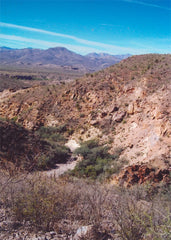Sonora Dendritic Location

In 2009, a man was chasing one of his goats up a mountain slope a few kilometers from the pueblo where he lived. He stumbled over some rock that he thought looked unusually pretty and picked some up. In 2011 some of this rock was offered for sale at the Tucson and Quartzsite Show in Arizona. It was well received with beautiful, feather-like dendritic patterns on different colored backgrounds.
The rock is simply called Sonora Dendritic because of the strong dendritic patterns and is found in the state of Sonora, Mexico. The state of Sonora is directly south of Arizona and California.
The rock has a blue-gray or yellow background color with maroon colored dendrites growing off sealed fracture lines. The dendrites are surrounded by white halos as if their formation absorbed color from the surrounding rock. Sometimes the base color can contain some pink color and be softly banded like hickorite or wonderstone. The sealed fracture pattern is similar to the sealed fracture patterns in the Owyhee Jasper from Oregon and the maroon color of the dendrites is very similar to the color of the dendritic pattern in the jasper from New Mexico called Apache Sage. The material is opaque and is softer than jasper or rhyolite. The rock is probably an altered dolomite that has been heated, cracked, and resealed by volcanic activity.
In the spring of 2011, after considerable searching, I asked Agata Exploraciones SA de CV if they could find the source for this material. Agata Exploraciones found the man who chased the goat up the mountain and arranged for a trip for me to visit the deposit. In November 2011 I made the trip with my friend, Ernesto. We traveled south from Nogales and then east over several mountain ranges. The state of Sonora generally rises to the east from the Pacific Ocean until it reaches at the crest of the Sierra Madres which marks the border with Chihuahua. The eastern part of Sonora is rugged, remote, and sparsely populated with small pueblos in the river valleys. Note the photo for one of these pueblos saying it was founded in 1639.
There are no roads to the deposit. We drove on dirt roads to a river, drove through the river and up a creek bed on the other side of the river. When we could not drive any farther (low-range 4-wheel drive country) we started walking, following a burro trail up the cliffs to the mountain slopes. From the rock that I had seen I was hoping there would be a long ledge of rock that could be effectively mined. This was not the case. The whole top of this mountain seems to be made of this rock but it is all grainy and uninteresting.
The areas where the dendritic pattern is "clean" and not grainy are isolated, not very big, and spread out all over the mountain. All the rock is being mined by hand and hauled down to the creek bed on burrows. It can then be put into a 4-wheel drive pick-up and driven across the river. If the river is too high it cannot be crossed until the river is lower.
I had extensive conversations with the miners about the deposit and the quality of the rock they were producing. In the end, The Gem Shop made a deal through Agata Exploraciones to purchase all of the production.









